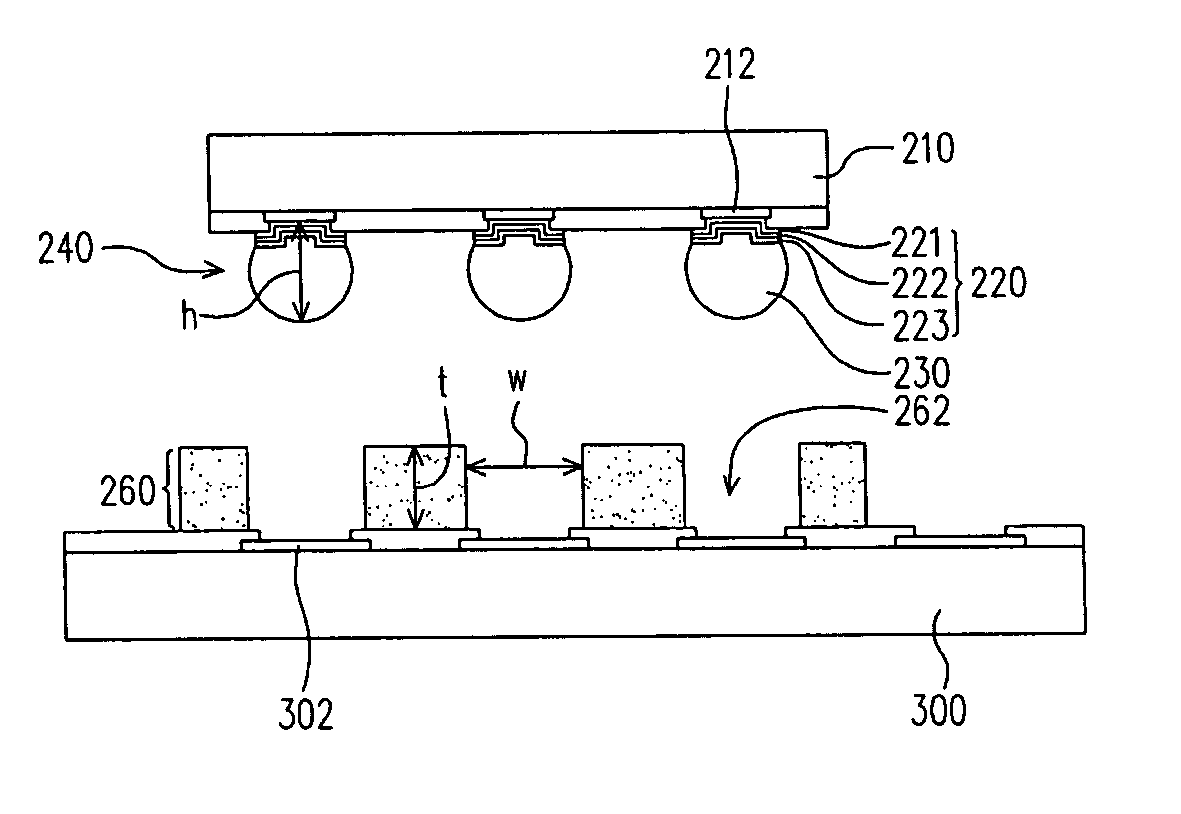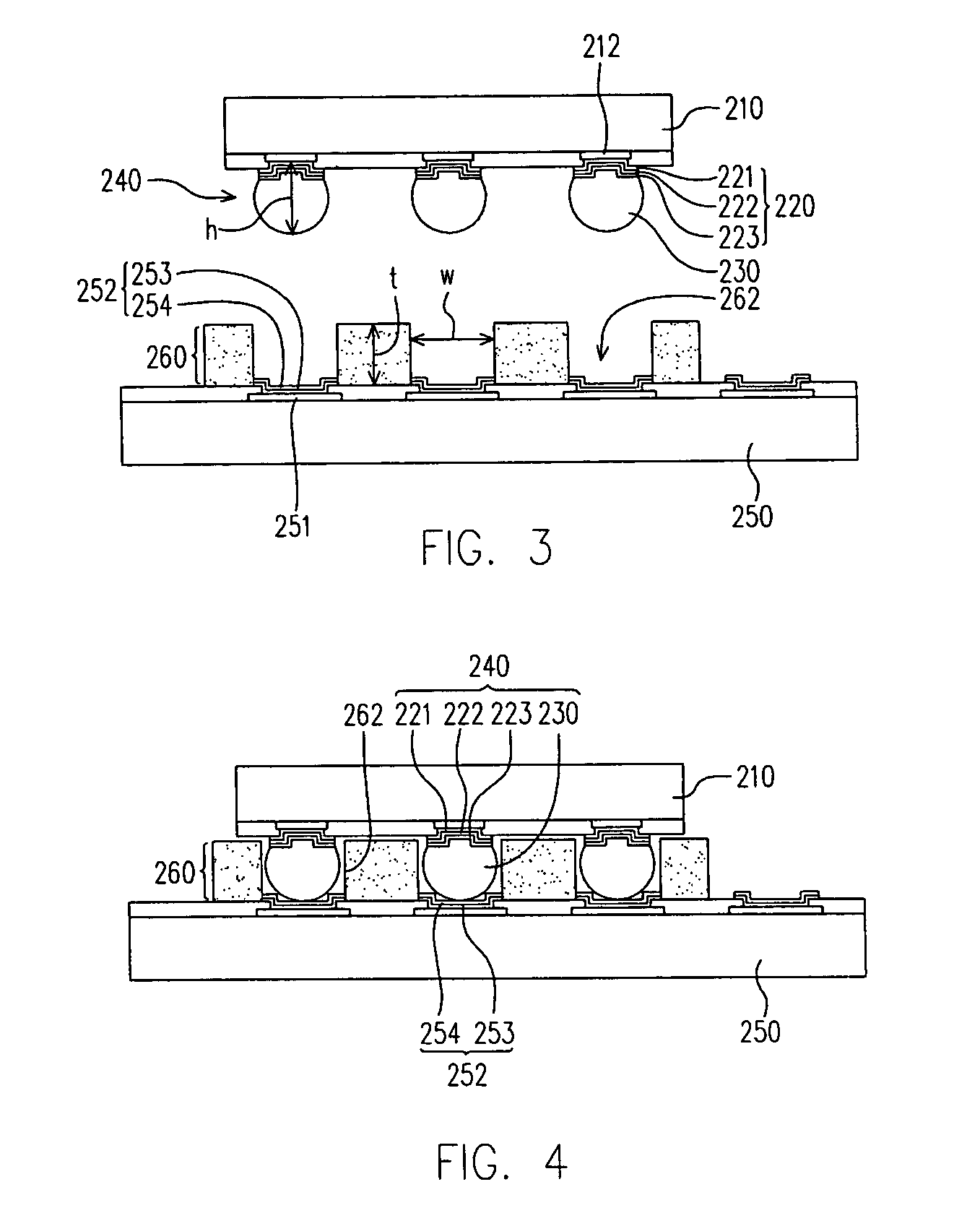Chip bonding process
a technology of chip and bonding process, which is applied in the direction of semiconductor/solid-state device details, electrical equipment, semiconductor devices, etc., can solve the problems of low productivity and introduction of a great deal of design limitation
- Summary
- Abstract
- Description
- Claims
- Application Information
AI Technical Summary
Benefits of technology
Problems solved by technology
Method used
Image
Examples
first embodiment
[0022] Referring to FIGS. 3-5, cross-sectional views showing a chip bonding process according to a first preferred embodiment, multiple chips 210 (only one shown in FIGS. 3-5) are provided with a number of aluminium or copper pads 212. The chip 210 comprises a semiconductor substrate with multiple active devices, such as transistor or CMOS, and an interconnecting metallization layer formed on the semiconductor substrate. The pads 212 are connected to the interconnecting metallization layer. Multiple bumps 240 are respectively formed on the pads 212 of the chip 210. The bumps 240 are deposited, for example, by forming a UBM (Under Bump Metallurgy) layer 220 on the pads 212 of the chip 210, followed by forming a solder material 230 on the UBM layer 220 and then performing a reflowing process which makes the solder material 230 ball-shaped, wherein the height h of the bumps 240 ranges from about 5 μm to 400 μm.
[0023] The UBM layer 220 is deposited, for example, by sputtering an adhesi...
second embodiment
[0037] The process mentioned above is applicable not only to forming an underfill between two chips but also to forming an underfill between a chip and a substrate, as shown in FIG. 6. FIG. 6 is a cross-sectional view showing the bonding of a chip and a substrate according to a second preferred embodiment.
[0038] At first, a number of bumps 240 are formed on the pads 212 of the chip 210. The bumps 240 herein may have the same structure or materials as the bumps 240 described in the first embodiment. Next, a patterned polymer layer 260 is formed on a substrate 300 such as printed circuit board. There are multiple openings 262 formed in the patterned polymer layer 260 and exposing multiple pads 302 of the substrate 300. The patterned polymer layer 260 may have a thickness between about 5 μm and 400 μm and, preferably, between about 10 μm and 100 μm. The structure of the patterned polymer layer 260 and the process for forming the same can be referred to the first embodiment.
[0039] The...
third embodiment
[0040] In the process for forming the underfill mentioned above, each of the openings in the patterned polymer layer exposes only one pad. However, the invention can not be limited to the above embodiments. As shown in FIG. 7, a top view showing an underfill formed on a wafer or a substrate according to a third preferred embodiment, multiple socket-shaped openings 462 are formed in the patterned polymer layer 460. Each of the socket-shaped openings 462 may expose multiple aligned pads 252 of the wafer 250. Alternatively, the openings in the patterned polymer layer may have various shapes. The structure of the patterned polymer layer 460 and the process for forming the same can be referred to the detail of the patterned polymer layer 260 described in the first embodiment. The only difference between the patterned polymer layers 260 and 460 is the shape of the openings 262 and 462.
[0041] The patterned polymer layer 460 described in the third preferred embodiment not only can serve as...
PUM
 Login to View More
Login to View More Abstract
Description
Claims
Application Information
 Login to View More
Login to View More - R&D
- Intellectual Property
- Life Sciences
- Materials
- Tech Scout
- Unparalleled Data Quality
- Higher Quality Content
- 60% Fewer Hallucinations
Browse by: Latest US Patents, China's latest patents, Technical Efficacy Thesaurus, Application Domain, Technology Topic, Popular Technical Reports.
© 2025 PatSnap. All rights reserved.Legal|Privacy policy|Modern Slavery Act Transparency Statement|Sitemap|About US| Contact US: help@patsnap.com



